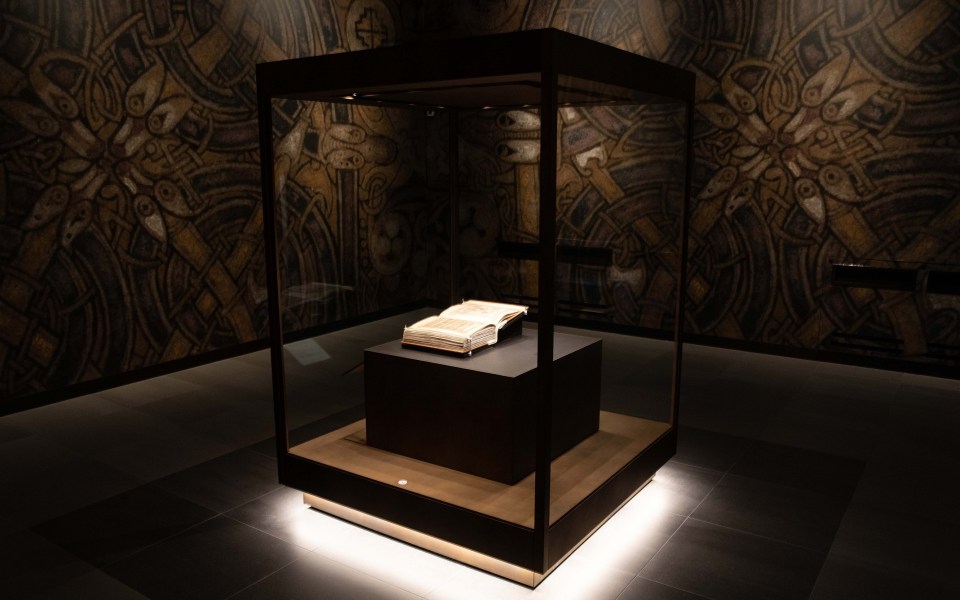
Visit the Book of Kells and Old Library and experience the history like never before
Visit the Book of Kells and Old Library and experience the history like never before


The Book of Kells is known internationally as one of the finest surviving examples of early medieval art. But what exactly gives the 9th century manuscript, held in the Old Library of Trinity College Dublin, its renowned reputation?
One of the most richly decorated pages of the Book of Kells, named the Chi Rho page, makes this quite clear. The Chi Rho page belongs to the Gospel of St Matthew, which is the first of the four gospels of the New Testament text transcribed in the Book of Kells. Its decoration exemplifies the awe-inspiring, unique beauty of the insular art style used throughout the manuscript.
Hidden among the abstract patterns of interlocking spirals and swirling interlace, the Chi Rho page features a collection of animals, insects, snakes, angels, and other figures that all have deep symbolic meaning. Only the trained eye of a medieval scribe, or the keen observation of a modern-day viewer, would be able to spot them. In this article, I will point out some of their hiding places.

The Chi Rho is the monogram of Christ when spelled out in Greek. It is composed of the first two letters – Chi or the letter ‘X’, and the Rho or the letter ‘P’ – which overlap and combine to form the central motif of the page.
The Chi Rho is a symbol found often in Christianity, with its use dating back as far as the Roman Empire. It can also be found in some other early Christian manuscripts contemporary to the Book of Kells, such as the Book of Dimma from Co. Tipperary, and the Lindisfarne Gospels from the east coast of England.
The original function of the Book of Kells was as a ceremonial object, with its elaborately decorated pages such as the Chi Rho page being put out on display during important liturgical occasions.
Most people at the time of its creation 1,200 years ago were illiterate and could not understand the Latin transcription of the four gospels contained in the manuscript. It was for this reason that the visual imagery and detailed illustrations were essential for telling the stories of the gospels and communicating the messages of Christianity.
Symbolism and meaning have always been core aspects of Irish art, even in pagan times. With the arrival of Christianity to the region around the 4th century, the old, pagan artistic tradition was adapted by monks to convey new Christian meanings in their manuscripts.
In the Chi Rho page, these (often tiny) symbolic details blend seamlessly into the overall abstract pattern, unless you know where to look!
Every region where Christianity flourished across the world produced gospels and manuscripts in their own artistic and visual style. The Book of Kells, in this way, was part of a Christian tradition of manuscript production. However, the Chi Rho page reveals one way in which it was unique. It contains examples of almost all the varieties of design to be found in Celtic art, but used within a Christian context.
Pre-Christian, pagan art styles were brought in by the Celts from Europe and dominated the areas of Ireland and northern Britain. When Christianity arrived, it brought new Byzantine, Italian, Coptic, and other artistic influences. The fusion between the two resulted in an artistic style called ‘insular.’
In this way, the Chi Rho page is a pagan-Christian artistic fusion, a material manifestation of colliding influences at the dawn of a newly Christianised Irish society, a pivotal moment in the history of Ireland.
It could be said that it preserves the legacy of a pagan Ireland of feasts and festivals, while also illustrating the very beginnings of a Christianised Irish society which would continue for centuries.

Due to conservation considerations, the pages of the Book of Kells on display change several times a year. This is essential for the preservation of the manuscript in its entirety.
So if the Chi Rho page is not on display during your visit, you can explore the page in digital form through the Library of Trinity College Dublin Digital Collections, where you can zoom right in and appreciate the medieval artistic mastery for yourself. Just search for ‘Folio 34r.’
You can also see a large-scale reproduction of the Chi Rho page at the Old Library as part of the Book of Kells Experience. The page is reproduced on a much greater scale than the original, giving you a great chance to spot some of the intricate details mentioned in this blog.

Think about the impact that the imagery of the Chi Rho page would have had on the early medieval layperson. In the context of the very simplistic lifestyle they would have had, with very little exposure to visual material – the designs of the Chi Rho page would have been nothing less than astounding.
In many ways, this impact has not lessened over the centuries since the manuscript’s heyday. Visitors from all over the world visit the Book of Kells Experience each year, to have their own special moment with the manuscript in the Treasury where it is housed, to appreciate its artistic intricacy and beauty in person.
The Chi Rho remains awe-inspiring, as it has been for over 1,200 years, and draws a strong and lasting connection between our modern world, and that of an early medieval Ireland long before us.
Visit the Book of Kells and Old Library and experience the history like never before
